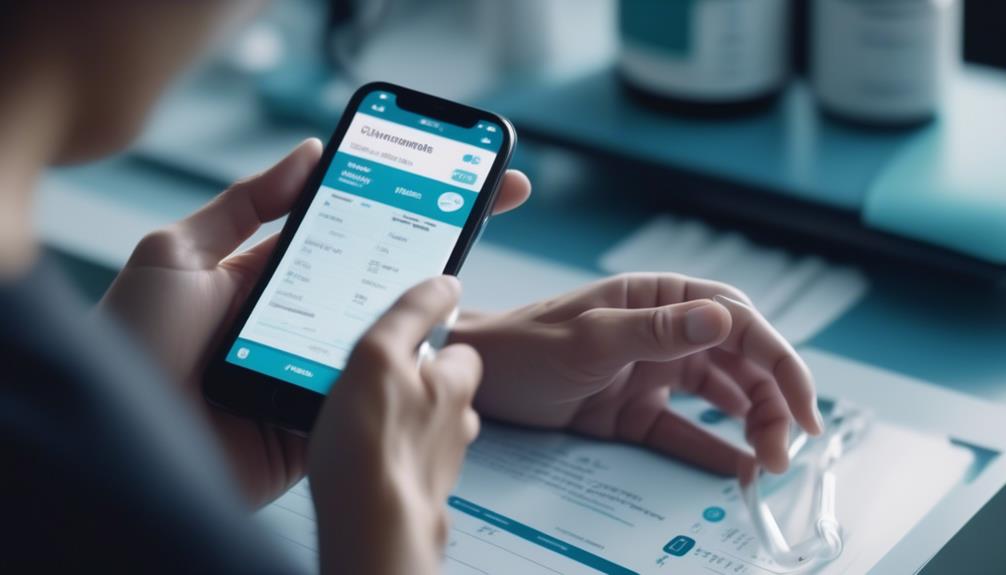The evolution of digital technology has revolutionized nearly every aspect of our lives, and healthcare is no exception. As the healthcare industry continues to embrace digital tools, the potential for enhancing patient engagement and satisfaction is vast.
From online appointment scheduling to personalized health tracking apps, the possibilities seem endless. The question then arises: how can these digital tools be effectively leveraged to not only improve patient experience but also drive better health outcomes?
This discussion aims to explore the various avenues through which digital tools can be harnessed to elevate patient engagement and satisfaction in the healthcare landscape.
Key Takeaways
- Online appointment scheduling and virtual consultations are digital tools that can enhance patient engagement and satisfaction.
- Personalized health tracking apps can help patients track their health goals and improve their engagement in their own care.
- User-friendly interfaces and data privacy measures are important considerations when implementing digital tools for patient engagement.
- Remote monitoring and telemedicine can improve access to care and enhance patient outcomes, leading to increased patient satisfaction.
Online Appointment Scheduling
Online appointment scheduling has become an increasingly prevalent and efficient method for healthcare providers to streamline the process of booking patient appointments and enhancing overall operational efficiency. By leveraging digital tools, healthcare facilities can offer improved communication and digital accessibility to their patients. This innovative approach allows patients to schedule appointments at their convenience, reducing the need for extensive phone calls and potential scheduling errors.
Moreover, digital accessibility ensures that patients can access the scheduling platform at any time, from any location, making the process more convenient and efficient.
Implementing online appointment scheduling systems not only benefits patients but also enhances the operational efficiency of healthcare providers. With the ability to view available time slots and select appointments online, patients can easily find a suitable time without the need for back-and-forth communication. This streamlined process allows healthcare staff to focus on providing quality care rather than managing appointment bookings. Additionally, it provides healthcare facilities with the opportunity to optimize their appointment schedules, leading to better resource allocation and improved overall patient satisfaction.
Virtual Consultations
The integration of virtual consultations has revolutionized the patient-provider interaction, offering a dynamic approach to healthcare delivery and fostering enhanced connectivity. Telehealth benefits have become increasingly evident as virtual care options have expanded, providing patients with convenient access to medical expertise while minimizing the need for in-person visits.
Virtual consultations offer numerous advantages, including increased access to specialists, reduced travel time and costs, and the ability to receive timely medical advice from the comfort of one's home. Moreover, these virtual care options have been instrumental in ensuring continuity of care during the COVID-19 pandemic, allowing patients to receive necessary medical attention without being physically present in a healthcare facility.
Additionally, virtual consultations have the potential to enhance patient engagement and satisfaction by enabling more frequent and convenient communication with healthcare providers. As technology continues to advance, virtual consultations are likely to play an increasingly integral role in healthcare delivery, providing a valuable means of improving patient outcomes and overall healthcare experience.
Personalized Health Tracking Apps
Personalized health tracking apps offer a user-friendly interface that allows individuals to easily input and access their health data. These apps also prioritize data privacy measures to ensure the security of sensitive information.
Additionally, they enable users to set and track their health goals, providing a comprehensive approach to managing and improving their well-being.
User-Friendly Interface
With a focus on enhancing user experience and promoting active engagement in personal health management, modern health tracking apps are designed to offer a user-friendly interface that prioritizes ease of use and accessibility. This approach aims to improve accessibility and user experience by providing intuitive features and a seamless navigation system.
The following features contribute to the user-friendly interface of personalized health tracking apps:
- Customizable Dashboards: Users can personalize their dashboards to display the most relevant health metrics and information, allowing for quick and easy access to essential data.
- *Personalized Notifications*: The apps offer customizable notifications to remind users of medication schedules, doctor's appointments, or important health-related tasks, ensuring they stay on top of their health management.
Data Privacy Measures
Enhancing data privacy within personalized health tracking apps necessitates the implementation of robust encryption protocols and stringent access controls to safeguard sensitive user information. Data security is paramount in ensuring that patient data remains confidential and secure from unauthorized access.
Personalized health tracking apps should employ end-to-end encryption to protect data both in transit and at rest. Additionally, multifactor authentication and role-based access should be implemented to ensure that only authorized individuals can access sensitive patient information.
Furthermore, obtaining patient consent for data collection and sharing is essential in upholding privacy standards. Apps should provide clear and transparent consent mechanisms, allowing users to understand and control how their data is being utilized.
Health Goals Tracking
Tracking health goals through personalized health apps enables individuals to monitor and manage their wellness objectives with precision and efficiency. These apps offer a range of features that support behavior modification and wellness coaching, empowering users to make informed decisions and stay motivated in achieving their health goals.
Some key functionalities include:
- Customized Goal Setting: Apps allow users to set personalized health targets, such as daily step counts, calorie intake, or water consumption, tailored to their specific needs and aspirations.
- Progress Tracking: Users can monitor their progress over time, receiving real-time feedback on their performance and celebrating milestones, which fosters a sense of accomplishment and encourages continued engagement.
Remote Monitoring and Telemedicine
Remote patient monitoring and telemedicine have revolutionized healthcare by allowing for continuous monitoring of patients' health conditions from a distance, leading to proactive and timely interventions.
The benefits of telemedicine are evident in improved access to care, especially for patients in remote or underserved areas.
Remote Patient Monitoring
The integration of remote patient monitoring, also known as remote monitoring and telemedicine, is revolutionizing the healthcare industry by enabling healthcare providers to effectively track and manage patient data outside of traditional healthcare settings. This technology offers numerous benefits, including improved patient outcomes and enhanced patient engagement strategies.
- Enhanced Data Collection and Analysis
Remote monitoring technology allows for continuous collection and analysis of patient data, enabling healthcare providers to identify trends and intervene proactively.
- Improved Access to Care
Patients in remote or rural areas can access healthcare services through telemedicine, leading to enhanced patient satisfaction and increased access to specialist care.
Remote patient monitoring is a pivotal component in shaping the future of healthcare, offering innovative solutions to improve patient care and outcomes.
Telemedicine Benefits
The integration of telemedicine into healthcare practices has emerged as a transformative means of extending medical services beyond traditional clinical boundaries, offering a wide array of benefits for both patients and healthcare providers.
Telemedicine has proven to be effective in improving patient outcomes by enabling remote monitoring and management of chronic conditions, reducing hospital readmissions, and enhancing access to specialized care in underserved areas.
Furthermore, telehealth expansion has streamlined healthcare delivery by facilitating virtual consultations, enabling timely interventions, and reducing the burden on in-person healthcare services.
The utilization of telemedicine technologies has demonstrated significant potential in enhancing patient engagement and satisfaction, while also optimizing resource allocation and improving overall healthcare system efficiency.
As telemedicine continues to evolve, its impact on transforming healthcare delivery and improving patient care outcomes is becoming increasingly evident.
Improved Access to Care
With the advent of remote monitoring and telemedicine, healthcare providers have gained unprecedented opportunities to extend medical care beyond physical constraints and improve patient access to a wide range of specialized services. This has led to several improvements in access to care, including:
- Improved Communication: Telehealth enables real-time communication between patients and healthcare providers, allowing for timely consultations and follow-ups without the need for in-person visits.
- Increased patient engagement and satisfaction through convenient and effective communication channels.
- Enhanced coordination among healthcare teams, leading to better continuity of care and outcomes.
These telehealth benefits have revolutionized the way healthcare services are delivered, breaking down geographical barriers and ensuring that patients can receive quality care regardless of their location.
Patient Education and Communication Platforms
Utilizing advanced patient education and communication platforms has become increasingly essential in modern healthcare for fostering informed decision-making and enhancing patient engagement and satisfaction.
Interactive learning tools enable patients to actively participate in their healthcare journey, promoting a deeper understanding of their conditions and treatment options.
Personalized communication platforms further enhance patient empowerment by delivering tailored information and support, catering to individual needs and preferences. These platforms not only facilitate the dissemination of medical knowledge but also encourage patients to take an active role in managing their health.
Moreover, virtual engagement through these platforms transcends geographical barriers, enabling healthcare providers to reach and educate a larger audience. Patients can access resources, attend virtual support groups, and interact with healthcare professionals at their convenience, thereby promoting continuous learning and engagement beyond traditional clinical settings.
Additionally, these platforms allow for seamless communication between patients and their care teams, fostering a collaborative approach to healthcare decision-making.
As healthcare continues to embrace digital transformation, patient education and communication platforms play a pivotal role in driving better health outcomes and overall satisfaction.
Feedback and Satisfaction Surveys
Amidst the increasingly essential role of advanced patient education and communication platforms in modern healthcare, the integration of feedback and satisfaction surveys serves as a valuable mechanism for gauging patient experiences and facilitating continuous improvement strategies. Feedback analysis is crucial in understanding patient experience and identifying areas for quality improvement. These surveys provide insights into patient satisfaction levels, allowing healthcare providers to address concerns promptly and enhance the overall quality of care. Moreover, they play a pivotal role in patient retention by demonstrating an organization's commitment to listening to and acting upon patient feedback.
- Subtopics:
- Real-time Feedback: Implementing digital tools for collecting real-time feedback enables healthcare providers to address issues promptly, thus improving patient experience and satisfaction.
- Data-Driven Decision Making: Leveraging feedback and satisfaction survey data for analytics and reporting allows healthcare organizations to make informed decisions, identify trends, and prioritize areas for improvement, ultimately enhancing the quality of care.
Conclusion
In conclusion, the integration of digital tools in healthcare has significantly improved patient engagement and satisfaction. According to a study by Accenture, 41% of patients believe that digital tools can enhance their overall experience with healthcare providers.
As technology continues to advance, the use of online appointment scheduling, virtual consultations, personalized health tracking apps, remote monitoring, telemedicine, patient education platforms, and feedback surveys will continue to play a crucial role in enhancing patient care and satisfaction.







